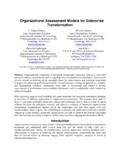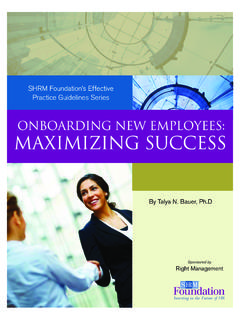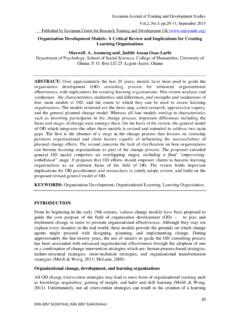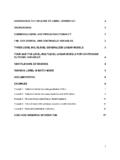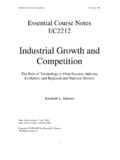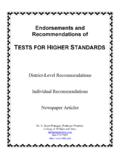Transcription of MODELS OF ORGANIZATIONAL EFFECTIVENESS
1 MODELS of ORGANIZATIONAL EFFECTIVENESS 1. MODELS OF ORGANIZATIONAL EFFECTIVENESS . Assistant Professor, Department of Business Management, Osmania University, Hyderabad 7. INTRODUCTION: Improving communication processes;. The complexity and competitiveness of today's business Team building and team environment requires that companies EFFECTIVENESS improvement;. continuously raise the bar on their Cohering management teams and EFFECTIVENESS . Retionalizing the complexities of Top performance increasingly ORGANIZATIONAL structure.
2 Demands excellence in all areas, including leadership, productivity, and adaptation to change, process OBJECTIVES OF THIS STUDY: improvement, and capability enhancement (knowledge, skills, 1. To study the assessments of abilities, and competencies). ORGANIZATIONAL EFFECTIVENESS which According to research, there are provide departments with a clear some directions to improve and objective view of the current state ORGANIZATIONAL EFFECTIVENESS , viz., of leadership, structure, processes, people and climate issues, often Process mapping and uncovering situations that inhibit measurement; complete success.
3 Process improvement 2. To study OE assessments which reveals the perceptions of what is.. Expert facilitation of internal This understanding, along with interventions;. partnered discussion about future Productivity improvement; needs and opportunities, creates a sound base for meaningful strategic Monitoring and evaluation; planning, visioning and/or mission definition. Measuring and assessing climate and culture; 3. To study OE activities which reaffirm that out most important 2 Osmania Journal of Management resource is people.
4 A talented and Review of Literature dedicated workforce is essential to ORGANIZATIONAL EFFECTIVENESS Liture reaching full potential. By developing Despite its elusive nature, employees' skills and knowledge, ORGANIZATIONAL EFFECTIVENESS has been departments realize gains in considered a critical concept in productivity and efficiency. ORGANIZATIONAL theory (Goodman &. Improved employee Pennings, 1980). Some of the earliest competencies, coupled with a MODELS developed were goal based collaborative environment and (Etzioni, 1960; Steers, 1977) but strong leadership, produce immediately identified as an desired goals.
5 Unsatisfactory construct since the selection of inadequate goals cannot To study the importance of people lead to an effective organization is a necessity for efficient (Miles, 1980; Mohr, 1983). These early ORGANIZATIONAL structures and MODELS gave way to system MODELS , processes and well-designed jobs. which focused on a broader set of OE assessments identify areas for variables and on measuring the improvement, while insuring means necessary to achieve the connectivity to customer needs, ORGANIZATIONAL goals (Miles, 1980).
6 And department objectives. But like goal based MODELS , relevant systems and key processes within the LIMITATIONS OF THE STUDY: ORGANIZATIONAL systems could be misdirected and prove inefficient if This article has discussed four they caused, even if unintended, MODELS of ORGANIZATIONAL undesirable external consequences EFFECTIVENESS only. It is not taken (Mohr, 1983). From these concerns the other MODELS into emerged the multiple-constituency consideration. MODELS designed to measure This study undergoes the EFFECTIVENESS not only internally but inconsistencies among OE with also as a function of customer respect to these four MODELS of OE.
7 Satisfaction (Connolly, Conlon &. Deustch, 1980). The most recently This study is concerned with profit developed MODELS that have managed and non profit organizations only. to obtain some level of agreement It is also posing a constraint on among ORGANIZATIONAL theorists this study. assume a multidimensional construct (Robbins, 1983; Ridley & Mendoza, 1993). A literature review conducted MODELS of ORGANIZATIONAL EFFECTIVENESS 3. for this paper yielded four these results are derived from the multidimensional MODELS worthy of public sector, the model and outcomes consideration and analysis.
8 Of this study suggest research possibilities for the non-profit sector. MODELS of ORGANIZATIONAL Despite its simplicity, a major EFFECTIVENESS difficulty in using this model as a measure of ORGANIZATIONAL The first model comes from a EFFECTIVENESS in comparing for-profit study performed on contemporary and non-profit organizations is the Indian organizations and proposes relative interpretation of the that ORGANIZATIONAL structure has the commitment and productivity potential to improve the overall components. It is thought that perceived EFFECTIVENESS of the commitment in the for-profit domain organization (Bhargava & Sinha, is tied to career progression, personal 1992).
9 In this study, a 7-point scale income and business survival, applied to four specific components whereas commitment for non-profits was used to predict ORGANIZATIONAL is based on generosity and EFFECTIVENESS . Specifically, the volunteerism, which may not have a components were production, bearing on ORGANIZATIONAL commitment, leadership and EFFECTIVENESS . The concept of interpersonal conflict. Production was productivity in the non-profit sector defined as the flow of output of the is less tangible and more perceptual organization.
10 Commitment was than in the for-profit sector. With the established as a component to noted refinements the model might be measure the degree of attachment to used for both sectors. the organization. Leadership was defined as a degree of influence and The second ORGANIZATIONAL personal ability. Interpersonal conflict EFFECTIVENESS construct is also based refers to the degree of perceived on interrelated ORGANIZATIONAL misunderstanding between processes and was recently developed supervisors and subordinates. This primarily as a tool for management study shows that an organization consultants (Ridley & Mendoza, with a heterarchical structure was 1993).

